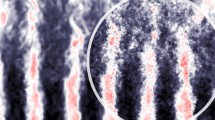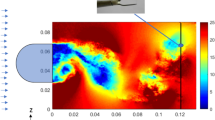Abstract
Three different particle image processing algorithms have been developed for the improvement of PIV velocity measurements characterized by large velocity gradients. The objectives of this study are to point out the limitations of the standard processing methods and to propose a complete algorithm to enhance the measurement accuracy. The heart of the PIV image processing is a direct cross-correlation calculation in order to obtain complete flexibility in the choice of the size and the shape of the interrogation window (IW). An iterative procedure is then applied for the reduction of the size of IW at each measurement location. This procedure allows taking into account the local particle concentration in the image. The results of this first iterative processing, applied to synthetic images, show both a significant improvement of measurement accuracy and an increase of the spatial resolution. Finally, a super-resolution algorithm is developed to further increase the spatial resolution of the measurement by determining the displacement of each particle. The computer time for a complete image processing is optimized by the introduction of original data storage in Binary Space Partitions trees. It is shown that measurement errors for large velocity gradient flows are similar to those obtained in simpler cases with uniform translation displacements. This last result validates the ability of the developed super-resolution algorithm for the aerodynamic characterization of large velocity gradient flows.










Similar content being viewed by others
References
Carosone F, Cenedese A, Querzoli G (1995) Recognition of partially overlapped particles using the kohonen neural network. Exp Fluids 19:225–232
De Berg M, Van Kreveld M, Overmars M, Schwarzkopf O (2000) Computational geometry. Algorithms and applications. Springer, Berlin Heidelberg New York
Etoh T, Takehara K, Okamoto K (1998) The particle mask correlation method In: 8th symposium on flow visualisation. Sorrento, Italy
Fuchs H, Kedem ZM, Naylor BF (1980) On visible surface generation by a priori tree structures. In: Proceedings of the 7th annual conference on computer graphics and interactive techniques, Seattle, Washington, USA
Hart DP (1998) High speed PIV analysis using compressed image correlation. J Fluids Eng 120:463–470
Honoré D, Lecordier B, Susset A, Jaffré D, Perrin M, Most JM, Trinité M (2000) Time resolved Particle Image Velocimetry in confined Bluff-Body burner flames. Exp Fluids 29:S248–S254
Huang HT, Fiedler HE, Wang JJ (1993) Limitation and improvement of PIV---part I: limitation of conventional techniques due to deformation of particle images patterns. Exp Fluids 15:168–174
Huang HT, Fiedler HE, Wang JJ (1993) Limitation and improvement of PIV part II: particle image distorsion, a novel technique. Exp Fluids 15:263–273
Ishikawa M, Murai Y, Wada A, Iguchi M, Okamoto K, Yamamoto F (2000) A novel algorithm for particle tracking velocimetry using the velocity gradient tensor. Exp Fluids 29:519–531
Lecordier B (1997) Etude de l’interaction de la propagation d’une flamme prémélangée avec le champ aérodynamique, par association de la tomographie laser et de la vélocimétrie par images de particules. PhD Thesis, Université de Rouen
Quénot GM (2000) Vélocimétrie par images de particules stéréo par programmation dynamique. In: 7ème Congrès Francophone de Vélocimétrie Laser, Marseille, France
Quénot GM, Pakleza J, Kowalewski T (1998) Particle image velocimetry with optical flow. Exp Fluids 25:177–189
Roth GI, Katz J (2001) Five techniques for increasing the speed and accuracy of PIV interrogation. Meas Sci Technol 12:238–245
Sacarano F, Riethmuller ML (1999) Iterative multigrid approach in PIV image processing with discrete window offset. Exp Fluids 26:513–523
Stanislas M, Okamoto K, Kähler CJ, Westerweel J (2005) Main results of the second international PIV Challenge. Spec Issue Exp Fluids (To appear)
Susset A, Trinité M, Honoré D, Jaffré D, Perrin M (1998) Experimental investigation of spatio-temporal correlation between aerodynamic and flame front location in an axisymetric non premixed Bluff-Body burner flame. In: 9th International symposium on application of laser techniques to fluid mechanics, Lisbon, Portugal
Susset A, Most JM, Honoré D, Perrin M (2000) Développement d’un traitement itératif par corrélation directe pour l’application de la PIV aux écoulements à forts gradients de vitesse. In: 7ème Congrès Francophone de Vélocimétrie Laser, Marseille, France
Susset A, Most JM, Honoré D, Lecordier B, Trinité M (2002) Suivi temporel d’une flamme de brûleur Bluff-Body par PIV haute cadence. In: 8ème Congrès Francophone de Vélocimétrie Laser, Meudon, France
Susset A (2002) Développement de traitements d’images pour l’étude de la stabilisation de flammes turbulentes non-prémélangées générées par des brûleurs industriels modèles. PhD Thesis, Université de Poitiers
Tokumaru PT, Dimotakis PE (1995) Image correlation velocimetry. Exp Fluids 19:1–15
Watt A., Policarpo F (2000) 3D Games. Real-time rendering and software technology, vol 1. Addison Wesley, Reading
Acknowledgements
Authors wish to thank the Poitou Charentes Regional Council and Gaz de France for their financial support of a part of this work.
Author information
Authors and Affiliations
Corresponding author
Rights and permissions
About this article
Cite this article
Susset, A., Most, J.M. & Honoré, D. A novel architecture for a super-resolution PIV algorithm developed for the improvement of the resolution of large velocity gradient measurements. Exp Fluids 40, 70–79 (2006). https://doi.org/10.1007/s00348-005-0047-z
Received:
Revised:
Accepted:
Published:
Issue Date:
DOI: https://doi.org/10.1007/s00348-005-0047-z




